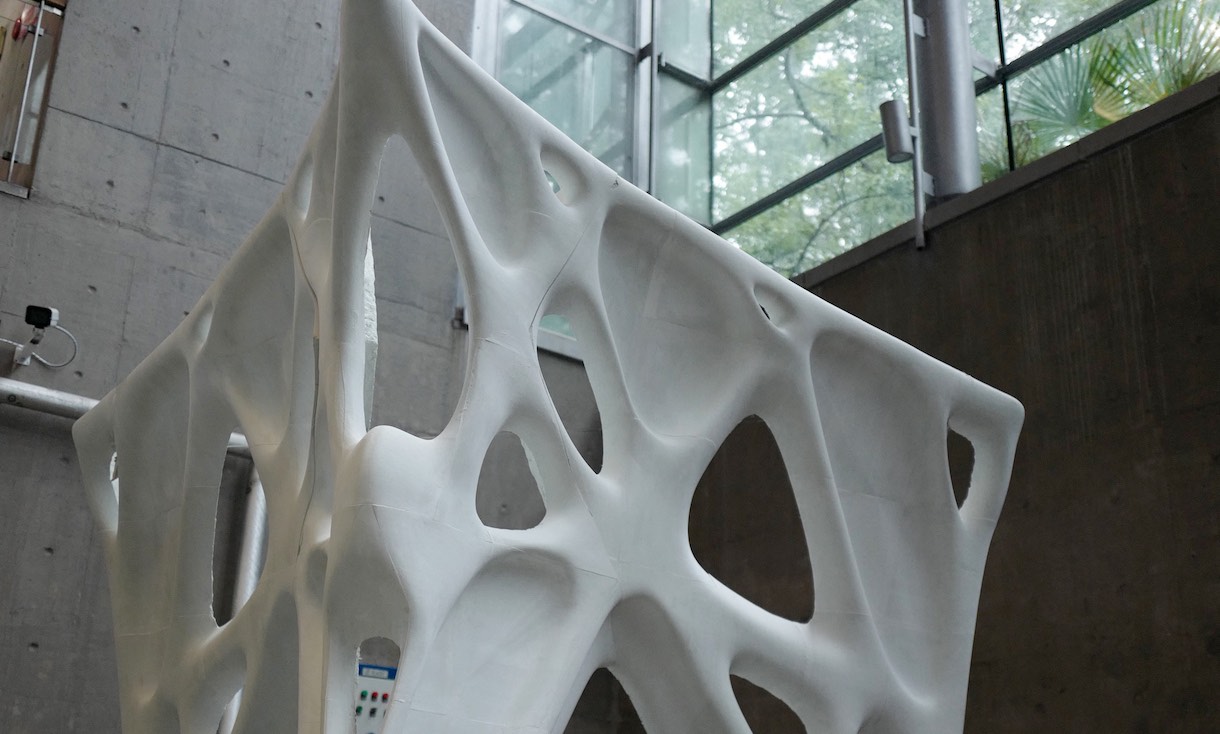Constructing innovative architectural installation & pavilion through topology optimisation and large-scale robotic 3D printing, Barcelona Spain, Melbourne Australia, and Shanghai China, 2019 – 2021

About the project
Due to the potential to generate forms with high efficiency and elegant geometry, topology optimization has been increasingly used in architectural and structural designs. This project presents a workflow of form-finding and robotic fabrication based on the Bi-directional Evolutionary Structure Optimization (BESO) method.
The workflow is an integration of emerging technologies in both digital design and advanced manufacturing, respectively topological optimization-based generative architectural form-finding and advanced robotic large-scale 3D printing. Innovative pavilions and installations, including X-form Pavilion and Intelligent Form, are produced using this workflow. Both large-scale 3D printing and robotic fabrication are used.
X-Form Pavilions
We designed two innovative X-Form Pavilions inspired by the branching columns of the Sagrada Familia. They are, respectively, X-Form 1.0 pavilion which was exhibited at the 9th DigitalFutures 2019 conference and expo in Shanghai, China, and X-Form 2.0, which was exhibited at the 60th International Association for Shell and Spatial Structure (IASS) conference and expo in Barcelona, Spain. We applied the BESO topology optimisation method to these two pavilions to create the tree-like branches in columns. Due to the different initial forms, boundary conditions, and parameters, the differences between the two pavilions are progressive. The size of these two pavilions is also gradually increased, respectively 2 x 2 x 2.5 m and 3.5 x 2.5 x 3.5 m. Due to their large sizes, the large-scale robotic fused deposition modelling (FDM) 3D printing technology was used to print the split parts to accelerate manufacturing speed. The PETG 3D printing polymer material was inexpensive. The transparent and reflective 3D printed surface also increased the aesthetic value.
Intelligent Form Installation
Intelligent Form was an innovative installation wall project. It was designed and tested in Melbourne, Australia and manufactured and exhibited in Shanghai, China. It was created by using the BESO technique and fabricated by fused filament fabrication (FFF) printed formwork and spraying ultra-high performance concrete (UHPC). The installation wall was 2.8 x 4.2 x 2.9 m and 450 kg. Due to the large size, the digital mould model was divided into 80 pieces. We also designed joints for different mould parts. The parts were printed and assembled in the factory, and the fibre reinforced UHPC concrete was sprayed on the assembled moulds layer-by-layer. After curing and demoulding, the polished concrete components were delivered to Tongji University and assembled for the 2021 DigitalFUTURES conference and expo. It exhibited both the heaviness of concrete and the lightness of the optimised structure.
In this project, a series of pavilions and installations have been designed and manufactured to demonstrate the combination of new design & construction techniques and illustrate the design & construction process. The developed workflow can be readily extended to the real buildings and building components.
Publications
Bao, D.W., Yan, X., Snooks, R., Xie, Y.M. (2020) Bioinspired generative architectural design form-finding and advanced robotic fabrication based on structural performance. In: Yuan P., Xie YM., Leach N., Yao J., Wang X. (eds) Architectural Intelligence. Springer, Singapore. [Full paper]
Bao, D.W., & Yan, X. (2019) From Topological-optimization-based Form Design to Large-scale Robotic Fabrication Technology, Time + Architecture 时代建筑,6,4-5. [Full paper]
Video
- YouTube: https://youtu.be/3a8EvG9dJhg
Key people involved in the project
- RMIT CISM: Ding Wen 'Nic' Bao, Xin Yan, Yi Min 'Mike' Xie
- China Construction Science & Technology Group: Jianan Peng, Wei Qiu
- RMIT Architecture | Tectonic Formation Lab & Architectural Robotic Lab: Roland Snooks


